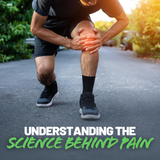The Secrets of Optimal Bone Health
Imagine your body as a house, with your bones as the essential framework holding everything together. Just as a well-built house needs a strong foundation, your body needs a healthy skeletal system to support your muscles, protect your vital organs, and enable you to move and function properly. To ensure your bones stay strong throughout your life, it's crucial to pay attention to your bone health.
As you age, your bones undergo a natural process known as remodeling, where old bone tissue is broken down and replaced by new, healthy tissue. However, if this process is out of balance, your bones can become weaker and more prone to fractures. We'll explore the key factors that contribute to optimal bone health, including bone density, nutrition, exercise, and lifestyle choices. We'll also discuss what steps you can take in your everyday life to properly care for your skeletal system.
Understanding Bone Density
Bone density is a measure of the amount of minerals, primarily calcium and phosphorus, found in your bones. This is important because a higher bone density generally indicates stronger bones that are less likely to break. Throughout your life, your bone density changes depending on factors such as age, gender, and overall health.
During childhood and adolescence, your bones grow in both size and density. This process continues until your early 20s when you reach your peak bone mass – the maximum amount of bone tissue you'll have throughout your life. From this point, bone density typically begins to decline gradually, making it essential to take steps to maintain the health of your bones as you age.
Low bone density can lead to conditions like osteoporosis, which increases your risk of fractures and can have a significant impact on your quality of life. By understanding how bone density plays a role in your overall bone health, you can take action to preserve your bone strength.
Nutrition for Optimal Bone Health
Your diet plays a significant role in maintaining strong bones. The two most important nutrients for bone health are calcium and Vitamin D. Calcium is a key building block of bone tissue, while Vitamin D helps your body absorb calcium from your diet.
To ensure you're getting enough of these essential nutrients, aim to include plenty of calcium-rich foods in your diet, such as dairy products, leafy greens, and fortified foods like orange juice and cereal. Additionally, try to get some sunlight each day, as this helps your body produce Vitamin D naturally. You can also find Vitamin D in fatty fish, eggs, and fortified foods.
Other nutrients that support bone health include phosphorus, magnesium, vitamin K, and protein. Incorporate a variety of fruits, vegetables, whole grains, lean meats, and healthy fats, like from avocados, nuts, and fish, into your diet to meet your nutritional needs and promote optimal bone health.
Exercise and Physical Activity
Regular physical activity is essential for maintaining strong bones. Weight-bearing exercises, such as walking, running, dancing, and resistance training, help stimulate bone formation and improve bone density. Aim for at least 30 minutes of weight-bearing exercise at least 3 days of the week to support your bone health.
In addition to weight-bearing exercises, balance and flexibility exercises, such as yoga and tai chi, can help improve your posture, coordination, and muscle strength, reducing your risk of falls and fractures.
Remember to start slowly and gradually increase the intensity of your workouts, especially if you're new to exercise. Always consult with a healthcare professional before beginning a new exercise routine, if you have any underlying health conditions or concerns about your bone health.
If you’re finding yourself too sore or in pain from exercise, you can incorporate STAMINAPRO patches into your workout routine. By targeting any inflammation or swelling brought on by exercising, you can help your body recover faster and eliminate any unnecessary down time! Start with 2 or more patches on the most worked out areas of your body for recovery from any soreness.
Lifestyle Factors
Some lifestyle factors that may contribute to weaker bones include:
- Smoking: Smoking decreases bone density by accelerating the decline in estrogen levels, particularly in women, and impairing calcium absorption, both of which contribute to bone loss and increased risk of osteoporosis. If you smoke, consider seeking help to quit.
- Excessive alcohol consumption: Excessive alcohol consumption can decrease bone density by interfering with the body's ability to absorb calcium, a key mineral for bone health, and by inhibiting the production of osteoblasts, the cells responsible for bone formation. Over time, this can lead to weakened bones, increased risk of fractures, and osteoporosis.
- Inadequate sleep: Poor sleep can decrease bone density due to disruptions in the normal regulation of bone metabolism, including impaired bone formation and increased bone resorption. Additionally, inadequate sleep can lead to hormonal imbalances, such as decreased growth hormone production, which can negatively impact bone health and contribute to reduced bone density. Aim for 7-9 hours of quality sleep each night.
- Stress: Chronic stress can decrease bone density through the increased production of stress hormones like cortisol, which can impair bone formation and increase bone resorption. Practice stress-relief techniques like mindfulness, meditation, or deep breathing exercises to help manage your stress levels.
By addressing these lifestyle factors, you can create a supportive environment for strong bones and a healthy skeletal system.
Regular check-ups with your healthcare provider are essential for monitoring your bone health, especially as you age. Your doctor may recommend a bone density test, such as a dual-energy x-ray absorptiometry (DEXA) scan, to assess your bone density and determine your risk of fractures. DXA is considered the gold standard for assessing bone mineral density (BMD) and is the most commonly used method for diagnosing osteoporosis and monitoring bone health. DXA scans are quick, non-invasive, and expose individuals to very low levels of radiation. The results can provide valuable information about bone health, fracture risk, and the effectiveness of treatment interventions for conditions like osteoporosis.
On top of regular check-ups, it's important to be proactive in maintaining your bone health by following the strategies discussed. If you have any concerns about your bone health or notice any changes in your mobility, posture, or strength, consult with your healthcare provider for guidance and support.







